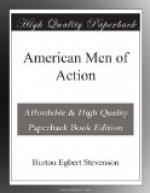Clark set off without delay on the long and dangerous journey, reached Williamsburg, gained an audience of Patrick Henry, the governor of Virginia, and painted the needs of Kentucky in such colors that he soon gained the sympathy of the impulsive and warm-hearted governor, and together they secured from the Assembly a large gift of lead and powder for the protection of the frontier. More than that, they succeeded in making Virginia acknowledge her responsibility for the new colony by constituting it the county of Kentucky. This, it may be added, put an end forever to Henderson’s dream of the independent colony of Transylvania.
Clark got his powder and ball safe to Harrodsburg just in time to repel a desperate Indian assault; but it was evident that there would be no safety for the Kentucky settlements so long as England controlled the country north of the Ohio. All that region formed a part of what was known as the Province of Quebec. Here and there dotted through it were quaint little towns of French Creoles, the most important being Detroit, Vincennes on the Wabash, and Kaskaskia and Kahokia on the Illinois. These French villages were ruled by British officers commanding small bodies of regular soldiers, and keeping the Indians in a constant state of war against their Kentucky neighbors, furnishing them with arms and ammunition, and rewarding them for every expedition they undertook against the Americans. They had no idea that any band of Americans which could be mustered west of the mountains would dare to attack them, and so were careless in their guard, and maintained only small garrisons at the various forts.
All this Clark found out by means of spies which he sent through the country, and finally, having his plan matured, he went again to Virginia in December, 1777, and laid before Governor Henry his whole idea, explaining in detail why he thought it could be carried out successfully. Henry was at once enthused with it, so daring and full of promise he thought it, and he enlisted the aid of Thomas Jefferson. The result was that when Clark set out on his return journey, it was with orders not only to defend Kentucky, but to attack Kaskaskia and the other British posts, and he carried with him L1,200 in paper money, and an order on the commander of Fort Pitt for such boats and ammunition as he might need.
With great difficulty, Clark got together a force of about a hundred and fifty men, one of whom was Simon Kenton. He could not get many volunteers from Kentucky because the settlers there thought they had all they could do to defend their own forts without going out to attack the enemy’s and only a few men could be spared. In May, 1778, this little force started down the Ohio in flat boats, and landing just before they reached the Mississippi, marched northward against Kaskaskia, where the British commander of the entire district had his headquarters. Clark knew that his force was outnumbered by the garrison




